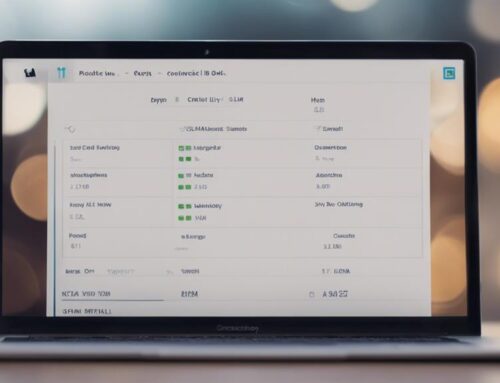Master data digitization with these 7 tips: automate processes for efficiency, validate data for accuracy, utilize OCR technology for conversion, cleanse data regularly, follow best practices for manual entry, organize data effectively, and convert files smartly. Enhance your data skills and drive your business forward.
Key Takeaways
- Implement automated processes for swift data extraction and handling.
- Utilize OCR technology for efficient data conversion from physical documents.
- Conduct data validation and cleansing for accuracy and reliability.
- Adhere to manual data entry best practices to avoid errors.
- Organize data effectively using universally recognized formats for better compatibility.
Automated Process
When digitizing data, consider implementing an automated process to streamline efficiency and accuracy. Data extraction plays a pivotal role in this process, ensuring that information is gathered from various sources accurately and promptly. By leveraging automation, you can optimize the entire digitization process, reducing manual errors and saving valuable time.
Automation enables swift data extraction from documents, emails, or other sources, eliminating the need for manual entry and minimizing the risk of human error. This streamlined approach not only enhances efficiency but also improves the overall accuracy of the digitized data. Process optimization through automation allows for a more systematic and structured way of handling information, leading to higher productivity levels.
Data Validation
When digitizing data, accuracy is paramount, and employing validation tools is crucial. Ensuring the integrity and reliability of your data is essential for making informed decisions. Validate to eliminate errors and guarantee the quality of your digitized information.
Accuracy Is Key
To ensure the integrity of your data, validating its accuracy is paramount. Data integrity relies heavily on the quality assurance processes you implement. Accuracy in data ensures that decisions made based on this information are reliable and effective. Errors in data can lead to incorrect conclusions and misguided strategies. By validating the accuracy of your data, you can trust that it reflects the real-world information it is meant to represent. Quality assurance measures, such as cross-referencing data points and conducting regular audits, play a crucial role in maintaining accurate data. Prioritizing accuracy in your data digitization efforts will enhance the overall quality and credibility of your database, ultimately leading to better-informed decision-making.
Validation Tools Are Essential
Utilizing reliable validation tools is crucial for ensuring the accuracy and credibility of your digitized data. Data integrity is maintained through rigorous quality control measures provided by these tools. By implementing validation processes, you can identify and rectify errors, inconsistencies, or missing information in your digitized data. These tools play a vital role in verifying that the data is complete, accurate, and consistent with the original source. Through systematic validation, you can enhance the overall quality of your digitized data, ensuring its reliability for decision-making and analysis purposes. Investing in validation tools is an essential step in the data digitization process to uphold data integrity and maintain high standards of quality control.
OCR Technology
In the realm of data digitization, OCR technology plays a pivotal role in converting printed text into digital format efficiently. OCR software, powered by advanced image recognition capabilities, enables the conversion of scanned documents or images into editable and searchable text. This technology is instrumental in automating data entry processes, saving time, and reducing human error.
OCR software functions by analyzing the shapes and patterns of characters within an image, translating them into machine-encoded text. Through its ability to recognize printed text, OCR technology facilitates the conversion of physical documents, such as invoices, receipts, or contracts, into editable formats that can be easily stored and accessed digitally.
Data Cleansing
Data cleansing is a critical process in ensuring the accuracy and reliability of your digital data assets. It involves identifying and correcting errors or inconsistencies in your dataset to improve data quality. By conducting data cleansing regularly, you can enhance the overall integrity of your information, leading to better decision-making and more reliable insights.
One of the main benefits of data cleansing is the improvement in data accuracy. By removing duplicates, correcting misspellings, and standardizing formats, you can minimize errors and ensure that your data is up-to-date and precise. This, in turn, enhances the quality of your database and prevents misleading conclusions based on faulty information.
Moreover, data quality is significantly enhanced through the process of data cleansing. By scrubbing your data of inaccuracies and inconsistencies, you can trust that the information you are working with is reliable and trustworthy. This attention to detail not only improves the efficiency of your operations but also boosts the credibility of your analyses and reports.
Manual Entry
When manually entering data, ensure accuracy is a top priority to avoid errors in your records. Consider utilizing automation tools to streamline the data entry process and reduce the risk of mistakes. By focusing on precision and leveraging technology, you can enhance the efficiency and reliability of your digitization efforts.
Accuracy in Data Entry
To ensure data accuracy during manual entry, double-check each input for errors before finalizing the entry. Error prevention is crucial in maintaining the integrity of the data. Implement quality control measures such as verifying data against the source document and using validation techniques. Avoid rushing through the data entry process as this increases the likelihood of mistakes. Take your time to input information accurately, reviewing each field for precision. It’s advisable to have a second set of eyes review the data entry for an additional layer of validation. By being meticulous and thorough in your manual data entry tasks, you can significantly reduce errors and enhance the overall quality of the digitized data.
Automation Tools for Entry
Double-checking each input for errors before finalizing the entry is a fundamental step in ensuring data accuracy during manual entry, and exploring automation tools can streamline this process further. Automation tools for manual data entry offer significant benefits in error detection and time efficiency. These tools can automatically flag potential errors as you input data, reducing the likelihood of mistakes. By implementing automation tools, you can speed up the data entry process, minimizing the time spent on manual verification. This not only improves the accuracy of your data but also enhances overall efficiency. Investing in automation tools that focus on error detection can save you valuable time and resources, making data digitization a more seamless and reliable process.
Data Verification
For effective data verification, ensure that the information entered matches the original source accurately. Data integrity is crucial in this process, ensuring that the data remains accurate and reliable throughout digitization. Quality control plays a significant role in verifying data, as it helps in identifying and rectifying errors or discrepancies promptly.
To maintain data integrity, establish validation rules that cross-check the entered data with the original source to guarantee accuracy. Implementing automated checks can streamline this process, flagging inconsistencies for further review. Regularly conducting quality control checks is essential to uphold the accuracy and consistency of the digitized data.
Utilize tools like checksums or algorithms to validate data accuracy, providing an additional layer of verification. Compare the digitized data against the source data to detect any anomalies that may have occurred during the digitization process. By prioritizing data verification and quality control, you can ensure the reliability and trustworthiness of your digitized information.
Data Formatting
Ensure data consistency by applying standardized formats during the digitization process, streamlining the organization and accessibility of information for improved data management. Data formatting plays a crucial role in data organization and file conversion. By structuring data consistently, you facilitate easier navigation and interpretation of information.
When digitizing data, opt for universally recognized formats such as CSV (Comma-Separated Values) or XML (eXtensible Markup Language) to enhance compatibility across various platforms. Consistent formatting ensures that data is accurately represented and can be seamlessly transferred between systems.
Proper data formatting also aids in efficient file conversion. When converting files from physical to digital formats, maintaining a standardized structure helps prevent data loss or corruption. By adhering to a uniform format, you simplify the conversion process and reduce the risk of errors.
Incorporating standardized data formats into your digitization workflow promotes data integrity and accessibility. Embrace consistent formatting practices to enhance data organization and streamline file conversion, ultimately optimizing your data management strategies.
Frequently Asked Questions
How Can Data Digitization Help in Reducing Operational Costs?
By digitizing data, you can streamline processes, leading to significant cost savings. This optimization allows for better resource allocation and efficiency. Furthermore, it provides a competitive edge and opens doors to innovation opportunities in your operations.
What Are the Potential Risks Involved in Data Digitization?
When digitizing data, potential risks include data privacy breaches and compliance challenges. Protect sensitive information from unauthorized access. Address legal requirements to avoid penalties. Stay vigilant to mitigate risks, ensuring data security and regulatory alignment.
How Can Businesses Ensure Data Security During the Digitization Process?
To ensure data security during digitization, you must prioritize data encryption and secure backups. By encrypting sensitive information and regularly backing up your data, you can safeguard against potential breaches and data loss effectively.
What Are the Best Practices for Integrating Digitized Data With Existing Systems?
To ensure seamless data integration, prioritize system compatibility. Verify software versions and formats align. Conduct thorough testing to detect and address any discrepancies. Regularly update and maintain systems to enhance efficiency and accuracy.
How Does Data Digitization Impact Overall Business Efficiency and Productivity?
Data digitization streamlines processes, enhancing business efficiency. By analyzing data, you improve decision-making. Boost customer engagement and tailor marketing strategies. Embrace the power of digitization to drive productivity, make informed choices, and elevate your business.




